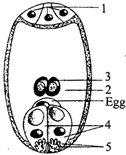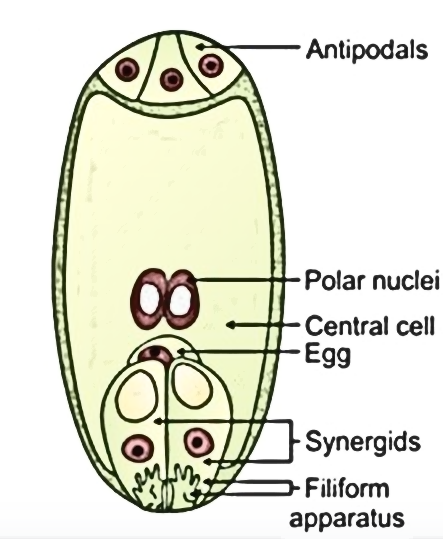
Identify 1, 2, 3, 4 and 5 structures shown in the figure of a female gametophyte respectively.

A. Antipodal cells, Central cell. Polar nuclei, Synergids and Acrosome
B. Antipodal cells, Central cell, Polar nuclei, Synergids and Filiform apparatus
C. Synergids, Central cell, Polar nuclei, Antipodal cells and Filiform apparatus
D. Synergids, Megaspore mother cell, Polar nuclei, Synergids, Filiform apparatus

Answer
358.8k+ views
Hint: >Eight nucleated and seven celled structures make up the mature embryo sac's structure. Its parts are located at its two ends. It is the blooming plant's female gametophyte.
Step by step solution:
The chalazal end and the micropylar end are the two endpoints that make up an angiosperm's typical mature embryo sac. Two cells with an egg apparatus known as synergids cells are located at the micropylar end.
The two synergid cells have a structure resembling a filiform apparatus that aids in directing the pollen tubes' passage into the embryo sac during fertilisation. Additionally, filiform serves the dual purposes of producing a lot of nectar and recognising pollen at the very early stages of stigma, in addition to aiding in the stimulation of division. Additionally, filiform aids in the movement of nutrients from the nucellus into the embryo sac. Three antipodal cells can be found at the chalazal end. When we can observe two polar nuclei, it indicates that there are two of them between the two ends. These two polar nuclei's purpose is to fuse together before fertilisation to create the diploid secondary nucleus. The embryo sac is referred to as being 7 celled and 8 nucleated because it contains eight nuclei in each of its seven cells.

So, option B is correct.
Note: Angiosperms have haploid embryo sacs, diploid zygotes, and triploid endosperms. It is haploid because it is produced from the megaspore mother cell following meiosis. The most prevalent form of the embryo sac in angiosperms is monosporic.
Step by step solution:
The chalazal end and the micropylar end are the two endpoints that make up an angiosperm's typical mature embryo sac. Two cells with an egg apparatus known as synergids cells are located at the micropylar end.
The two synergid cells have a structure resembling a filiform apparatus that aids in directing the pollen tubes' passage into the embryo sac during fertilisation. Additionally, filiform serves the dual purposes of producing a lot of nectar and recognising pollen at the very early stages of stigma, in addition to aiding in the stimulation of division. Additionally, filiform aids in the movement of nutrients from the nucellus into the embryo sac. Three antipodal cells can be found at the chalazal end. When we can observe two polar nuclei, it indicates that there are two of them between the two ends. These two polar nuclei's purpose is to fuse together before fertilisation to create the diploid secondary nucleus. The embryo sac is referred to as being 7 celled and 8 nucleated because it contains eight nuclei in each of its seven cells.

So, option B is correct.
Note: Angiosperms have haploid embryo sacs, diploid zygotes, and triploid endosperms. It is haploid because it is produced from the megaspore mother cell following meiosis. The most prevalent form of the embryo sac in angiosperms is monosporic.
Recently Updated Pages
Capping is a process in which A adenylate is added class 12 biology NEET_UG

Explain in brief the separation and isolation of DNA class 12 biology NEET_UG

Number of testicular lobules in testes is A 250 B 500 class 12 biology NEET_UG

Master Class 11 Economics: Engaging Questions & Answers for Success

Master Class 11 English: Engaging Questions & Answers for Success

Master Class 11 Social Science: Engaging Questions & Answers for Success

Trending doubts
What is BLO What is the full form of BLO class 8 social science CBSE

Which places in India experience sunrise first and class 9 social science CBSE

The shortest day of the year in India

What are the major means of transport Explain each class 12 social science CBSE

Which are the Top 10 Largest Countries of the World?

How many millions make a billion class 6 maths CBSE




